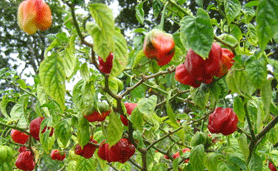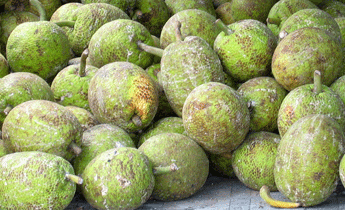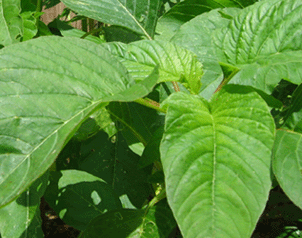
|
The international
guide to Jamaican restaurants and Caribbean restaurants |
Jamaican Foods-- Page
One

Ackees
Jamaican cuisine is healthy because
it is made with many unprocessed foods, uses smaller portions
of meats, has a high content of fish, beans, and vegetables,
and, most of all, because it is an eclectic mix of the best that
African, European, Indian, and Chinese cuisines have to offer.
Moreover, Jamaicans have always been aware of the relationship
between food and health. Perhaps Jamaican cuisine is healthy
due to luck or happenstance. How else can anyone explain why
some of the most highly rated medicinal herbs, e.g., ginger,
garlic, all spice and hot peppers just happen to be the basic
seasonings used in Jamaican cuisine.
In this section we will provide
information on some of the benefits of some common Jamaican foods.
Scotch Bonnet Peppers

|
|
The Scotch bonnet pepper is an essential ingredient of Jamaican
cooking because of its distinctive flavor. It looks almost identical
to a habanero pepper but it has its own unique flavor. To get
the flavor of the scotch bonnet without the heat, which is mostly
in the seeds, you can use the skin sparingly. Or use it whole
in soups and remove it without breaking the skin after the soup
is cooked. Scotch bonnet peppers are available at Jamaican food
stores, but be careful and ask questions, because many times
regular habanero peppers are sold as Jamaican scotch bonnet.
The Scotch bonnet (Capsicum
chinense) is a variety of Chile Pepper, similar to, and of the
same species as, the habanero. Habanero, which in Spanish means
from Havana, is heavily cultivated in Mexico's Yucatan province,
is the most intensely spicy chile pepper of the Capsicum genus.
Unripe habaneros are green, but the color at maturity varies.
Common colors are orange and red, but white, brown, purple, and
pink are also seen. Typically a ripe habanero is 2–6 cm
(1–2½ in) long. It is found mainly in the Caribbean
islands, with a shape resembling a Scot's bonnet. Most Scotch
bonnets have a heat rating of 150,000–325,000 Scoville Units.
Although habaneros are
believed to have originated in Cuba, it is nonetheless an important
part of cuisine in the Yucatán peninsula, where it is
often served roasted as a condiment with meals. Approximately
1,500 tons are harvested annually in the Yucatán.
Other producers include
Belize, Costa Rica, and some US states including Texas, Idaho,
and California.
The Scotch bonnet is often
compared to the habanero, as they are two varieties of the same
species. Both the Scotch bonnet and the habanero have the characteristic
thin, waxy flesh. They have similar heat level and flavor. Although
both varieties average around the same level of heat, the actual
degree of "spiciness" varies greatly with genetics,
growing methods, climate, and plant stress.
Pimento Berries
(also known as allspice)

|
|
Pimento is an essential
ingredient of Jamaican cooking and the essential ingredient in
jerk sauce. The wood was first used to smoke jerk in Jamaica
to produce the characteristic flavor. Nowadays the berries serve
as a good substitute. Dried pimento berries looks almost identical
to whole black pepper but it has a unique flavor. Pimento is
also a good home remedy for upset stomach in which case it is
either chewed or crushed up and used to make tea. It is used
in the preparation of beans not only because of its excellent
flavor but because it is believed to reduce the flautuance
caused by beans.
Pimento was discovered
in Jamaica by Spanish explorers in 1509. The named originates
from the Spanish 'pimenta' (pepper or peppercorn). Most people
call the tree "pimento' and the berries 'allspice'. Because
the pimento berry has the flavor and aroma characteristic of
cloves, nutmeg, cinnamon and pepper, all combined in one spice
it is called allspice.
Pimento is used in sauces,
pickling, commercial sausage preparations, and curry powders.
It is also used in many dishes, including cakes. It is used to
flavor barbecue sauces.
Coconuts
 Coconuts are widely available
in Jamaica and are consumed in a variety of ways. At early maturity
the coconut is mostly used for the refreshing beverage encased
in the kernel. At early maturity the "meat," or "flesh"
is very soft and delicate and constitutes a thin layer on the
inside of the kernel roughly an eighth of an inch thick. After
the "water" is consumed, the flesh spooned out and
consumed. At full maturity the coconut is used primarily to make
oil. The "meat," the white part of the coconut is crushed
and the oily liquid is extracted and distilled by boiling to
remove water leaving a residue of oil. The crushed-up coconut
is used in cakes and candy. Forget what you have heard about
this main staple of the Jamaican diet. Coconut oil is, "rich
in lauric acid, "which new research shows raises good type
HDL cholesterol, lowering heart disease risk, Lauric acid is
also anti-inflammatory, anti-bacterial and antiviral, says lipid
researcher Mary Enig, Ph.D., which also may help fight heart
disease." (USA Today Sept. 26-28 2003)
Breadfruit
Coconuts are widely available
in Jamaica and are consumed in a variety of ways. At early maturity
the coconut is mostly used for the refreshing beverage encased
in the kernel. At early maturity the "meat," or "flesh"
is very soft and delicate and constitutes a thin layer on the
inside of the kernel roughly an eighth of an inch thick. After
the "water" is consumed, the flesh spooned out and
consumed. At full maturity the coconut is used primarily to make
oil. The "meat," the white part of the coconut is crushed
and the oily liquid is extracted and distilled by boiling to
remove water leaving a residue of oil. The crushed-up coconut
is used in cakes and candy. Forget what you have heard about
this main staple of the Jamaican diet. Coconut oil is, "rich
in lauric acid, "which new research shows raises good type
HDL cholesterol, lowering heart disease risk, Lauric acid is
also anti-inflammatory, anti-bacterial and antiviral, says lipid
researcher Mary Enig, Ph.D., which also may help fight heart
disease." (USA Today Sept. 26-28 2003)
Breadfruit
 People in Jamaica and
St. Vincent roast breadfruit. In Trinidad and Tobago and Grenada,
the favorite way is "oil down, that is steamed in coconut
milk, while in the Leewards, they like it boiled. It can be turned
into flour, which then can be used to make bread. Ripe breadfruit
can be used to make breadfruit wine, patty, gizzada, pudding,
cake, and punch.'
People in Jamaica and
St. Vincent roast breadfruit. In Trinidad and Tobago and Grenada,
the favorite way is "oil down, that is steamed in coconut
milk, while in the Leewards, they like it boiled. It can be turned
into flour, which then can be used to make bread. Ripe breadfruit
can be used to make breadfruit wine, patty, gizzada, pudding,
cake, and punch.'
Callaloo
 You could say that Callaloo,
a leafy vegetable, plays a role in the Jamaican diet that is
similar to the role Spinach plays in the American diet. But that
would understate the importance of callaloo in the Jamaican diet.
And those who have had both agree callaloo has more going for
it than spinach. Steamed callaloo is often served with breakfast,
lunch and dinner. It is cooked with codfish and used in soups.
And it is used increasingly in non-traditional Jamaican dishes
such as quiche and omelets etc.
Callaloo is rich in nutrients
including : iron and other minerals, vitamin C, flavonoids and
other phytochemicals, calcium, and vitamin A. Callaloo has over
four times the calcium, over two times the iron, and over two
times the vitamin A compared to broccoli and other vegetables.
Go to Jamaican
Foods page 2
You could say that Callaloo,
a leafy vegetable, plays a role in the Jamaican diet that is
similar to the role Spinach plays in the American diet. But that
would understate the importance of callaloo in the Jamaican diet.
And those who have had both agree callaloo has more going for
it than spinach. Steamed callaloo is often served with breakfast,
lunch and dinner. It is cooked with codfish and used in soups.
And it is used increasingly in non-traditional Jamaican dishes
such as quiche and omelets etc.
Callaloo is rich in nutrients
including : iron and other minerals, vitamin C, flavonoids and
other phytochemicals, calcium, and vitamin A. Callaloo has over
four times the calcium, over two times the iron, and over two
times the vitamin A compared to broccoli and other vegetables.
Go to Jamaican
Foods page 2
Go to
Jamaican Foods page 3
|
International Pages |
USA Pages |
Phone:
206-339-9034
Fax:
206-339-9034
E-mail: eatjamaican@eatjamaican.com
©eatjamaican.com,
2015 |







